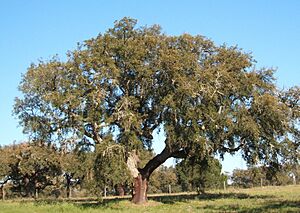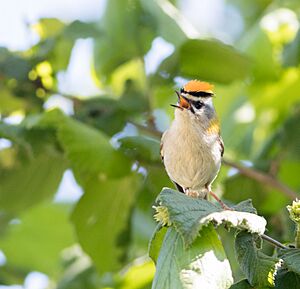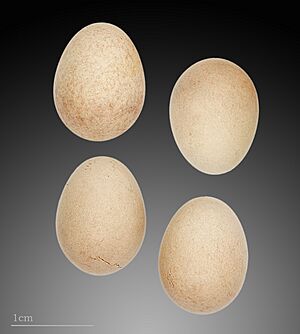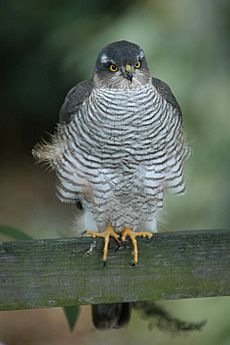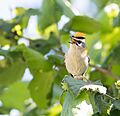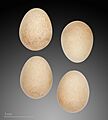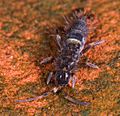Common firecrest facts for kids
Quick facts for kids Common firecrest |
|
|---|---|
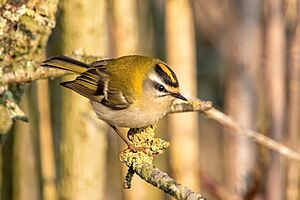 |
|
| Male of nominate subspecies in France | |
| Conservation status | |
| Scientific classification | |
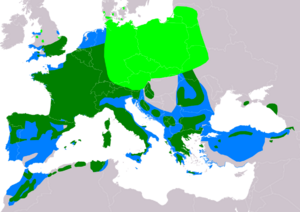 |
|
| Range of R. ignicapilla Breeding Resident Non-breeding |
The common firecrest (Regulus ignicapilla), also called the firecrest, is a very small passerine bird. It belongs to the kinglet family. These birds live in most of temperate Europe and northwestern Africa. Some firecrests migrate, moving south and west for winter.
Firecrests in the Balearic Islands and North Africa are a separate type, called a subspecies. But the firecrests on Madeira are now seen as their own species, the Madeira firecrest. Scientists found an ancient ancestor of the firecrest from a single wing bone.
This tiny bird is green on its back and whitish underneath. It has two white stripes on its wings. Its head has a black stripe across the eye and a white stripe above it. The male has a bright orange crest on its head, while the female has a yellow one. They show this crest during breeding. This crest gives the bird its name.
The firecrest looks a bit like the goldcrest, which lives in the same areas. But the firecrest has bronze shoulders and a strong face pattern that makes it different. Its song is a series of high, thin notes. These notes are a little lower in sound than the goldcrest's song.
Common firecrests build their nests in broadleaf or conifer woodlands and gardens. Their nests are small and built in three layers on a tree branch. The female lays 7 to 12 eggs and sits on them alone. Both parents feed the young birds. The chicks leave the nest about 22 to 24 days after hatching.
This kinglet is always moving. It often hovers in the air to find insects to eat. In winter, firecrests often join groups of tits. Even though some local groups might be getting smaller, the common firecrest is not in danger. This is because there are many of them in Europe. Also, their living area has grown over the last 100 years. Birds of prey might hunt them, and they can carry parasites. Some people think this bird was the original "king of the birds" in old European stories.
Contents
What the Common Firecrest Looks Like
The common firecrest is a small, round bird. It is about 9 centimeters (3.5 inches) long. Its wings can spread 13 to 16 centimeters (5 to 6 inches) wide. It weighs about 4 to 7 grams (0.14 to 0.25 ounces).
Its upper body is bright olive-green. It has a bronze patch on each shoulder. Its underside is whitish with brownish-grey on its chest and sides. It has two white stripes on its wings. Its bill is tiny, black, and pointed. Its legs are brownish-black.
The head pattern is very noticeable. It has a black stripe across its eye and a long white stripe above it. The crest on its head is bright yellow in females and mostly orange in males. Males and females look very similar, except for the crest color. Females are a little duller in color and slightly smaller.
Young firecrests have duller upper parts with a grey tint. They do not have the colored crest. Their other face markings are there but are not as bright as in adults. By their first winter, young birds look almost exactly like adults. This kinglet usually hops with its body held flat. Its flight is weak and whirring. It can make quick turns to get away from danger.
Adult firecrests are easy to tell apart from other birds. The Pallas's warbler has a similar head and wing pattern. But its crown stripe is pale yellow, not bright yellow or orange. Its stripe above the eye is also pale yellow, not bright white. Young common firecrests might be confused with goldcrests. But young firecrests usually have enough face pattern to tell them apart. Goldcrests have a very plain face at all ages.
The firecrest can also be told apart from Pallas's warbler. The warbler has a pale crown stripe and a yellow rump. It is more likely to confuse a young firecrest with the yellow-browed warbler. This warbler has a similar head pattern. But the warbler has pale edges on its folded wing feathers. It also has a whitish belly and darker brown legs. The yellow-browed warbler also does not have the pale half-circle under the young firecrest's eye.
Firecrest Family and Names
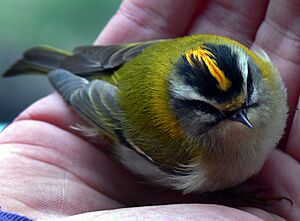
Kinglets are a small group of birds. They are sometimes put with the Old World warblers. But often, they are given their own family group. This is because recent studies show that kinglets are not closely related to warblers. The family name, Regulidae, and the group name, Regulus, come from a Latin word. Regulus means "little king." This refers to the orange or yellow crests on adult kinglets' heads.
The common firecrest was first officially described in 1820. A Dutch scientist named Coenraad Jacob Temminck gave it the name Sylvia ignicapilla. People thought it was just a type of goldcrest for a long time. The species name ignicapilla comes from Latin words. Ignis means "fire" and capillus means "hair."
There are two main types of common firecrest that scientists agree on. One is the main type, R. i. ignicapilla. The other is the Mediterranean type, R. i. balearicus. This second type lives on the Balearic Islands and in North Africa. It is a little paler underneath and greyer on top than the main type.
The Madeira firecrest, R. madeirensis, used to be thought of as a type of common firecrest. But genetic studies showed that the Madeira bird is a different species. Its genes are 8.5% different from the European bird. This is similar to how different other kinglet species are from each other. The Madeira bird also looks and sounds different. So, in 2003, scientists agreed to make it a separate species.
Ancient Firecrests
Scientists have found some very old records of Regulus birds in Europe and Israel. Most are goldcrests or cannot be identified. But one fossil from Spain was a firecrest. A wing bone found in Bulgaria belonged to an ancient species, Regulus bulgaricus. This bird lived about 2.6 to 1.95 million years ago. It seems to be an ancestor of the common firecrest.
Where Firecrests Live and Their Homes
The common firecrest breeds in lowland broadleaf forests. They like cork oak and alder trees if they can find them. Otherwise, they use beech and holly trees. They also live in mixed forests with broadleaf and conifer trees. These include spruce, European silver fir, cedar, and pine trees. Often, these areas have bushes like juniper, ivy, and wild rose.
In drier Mediterranean places, they live in conifers, evergreen oak, and mixed woodlands. They can be found up to 2,800 meters (9,200 feet) high. Unlike birds that need large forests, firecrests do not. Their numbers do not depend on how big the forest is. In winter, they do not rely on conifer trees as much as goldcrests. They move from forests to edges and bushes.
Firecrests are usually seen alone or in pairs. They spend a lot of time in the tops of trees. But they often go into bushes and other lower plants. These birds can live well in cities. They just need suitable places like parks or large gardens. The number of firecrests in gardens can be as high as in natural areas.
The main type of firecrest breeds in Europe. This goes from southern England, France, Spain, and Portugal. It stretches east to Belarus, northwestern Ukraine, and Greece. It goes north to the Baltic Sea and southern Latvia. There are also small groups living further east in Abkhazia, the Crimea, and Turkey.
Birds in the south usually stay in one place. But birds from the north and east migrate. They spend winter mainly in Mediterranean areas and western Europe. This goes from Portugal north to Britain. The R. i. balearicus type lives in the Balearic Islands and northern parts of Morocco, Algeria, and Tunisia. Firecrests have also been seen in places like Norway, Finland, Estonia, and Egypt. In 2020, common firecrests were reported nesting in southern Finland.
Firecrest Life and Habits
Breeding and Life Cycle
Common firecrests have one mate. During breeding season, the male sings. He often raises his crest. He also has a special display. He points his bill at another bird, showing his crest and strong face pattern. This is different from the goldcrest's display. The goldcrest has a plainer face and bows its head to show its crest.
A firecrest's breeding area is about 0.5 hectares (1.2 acres). This area might overlap with goldcrest territories. Firecrests sometimes defend their areas from goldcrests. They raise their crests and flutter their wings a lot. But they might not compete much for resources. In one study, conflicts were more common when one species greatly outnumbered the other. Otherwise, the two kinglets learned to ignore each other's songs. In his courtship display, the male firecrest raises his crest. He points it towards his mate and hovers over her before they mate.
The nest is often hung from a branch. It is usually not very high up. But some nests have been found as high as 20 meters (66 feet). Firecrests might like to nest near northern goshawk nests. Goshawks hunt birds that might eat firecrest eggs or young. These include Eurasian sparrowhawks, grey squirrels, Eurasian jays, and great spotted woodpeckers.
Like other kinglets, the nest is a closed cup. It is built in three layers with a small opening near the top. The outside layer is made of moss, small twigs, cobwebs, and lichen. Spider webs also help attach the nest to thin branches. The middle layer is moss. The inside is lined with feathers (up to 3,000!) and hair. The nest is smaller and deeper than a goldcrest's nest. It is about 8 centimeters (3 inches) across and 5 to 7 centimeters (2 to 2.8 inches) deep. The walls are about 2 centimeters (0.8 inches) thick. The female builds the nest alone. The male stays with her while she builds it. This takes a few days to three weeks.
Laying eggs starts in western Europe in late April. In the east, it starts in late May. Second groups of eggs are common. They are laid in June to July. The eggs are pink with very faint reddish marks on the wide end. Madeira firecrest eggs are different. They are white with some brown spots. The eggs are 14 x 10 millimeters (0.55 x 0.39 inches) and weigh 0.7 grams (0.025 ounces). About 5% of the weight is the shell. In Europe, they lay 7 to 12 eggs. In northwest Africa, it is probably fewer.
The female sits on the eggs for 14.5 to 16.5 days until they hatch. She also keeps the chicks warm. The chicks leave the nest 8 to 10 days later. Both parents feed the chicks and young birds that have left the nest. Firecrests become ready to breed after one year. They usually live for less than two years.
Even though goldcrests and firecrests live in the same areas, they usually do not breed together. This is because their courtship dances are different. Their face patterns are also different.
What Firecrests Eat
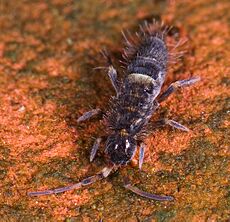
All kinglet species eat mostly insects. They hunt small arthropods with soft bodies. These include springtails, aphids, and spiders. They also eat the cocoons and eggs of spiders and insects. Sometimes, they eat pollen. All kinglet species will hover in the air to catch flying insects.
Firecrests and goldcrests are similar in size and often found together. But they eat different things. Common firecrests prefer bigger prey than goldcrests. Both will eat insects caught in spider webs during autumn migration. But firecrests will also eat large orb-web spiders. (Sometimes, kinglets have been found stuck in a spider web, unable to move or dead.)
The common firecrest feeds in trees. In conifer trees, they mostly look on the top of branches. In deciduous trees, they look on the top of leaves. This is different from the goldcrest. Goldcrests often feed on the undersides of branches and leaves. In winter, groups of common firecrests move about three times faster than goldcrests. They ignore the smallest prey that goldcrests like. They kill large invertebrates by hitting them against a branch many times.
Young common firecrests are fed almost only springtails. They do not accept larger food items. Sometimes, they spit up spiders. After five days, the chicks' diet includes aphids and many snail shells. The snail shells are needed for their bones to grow. After two weeks, their food includes larger moths and caterpillars. They also eat other arthropods that adults usually avoid. These include harvestmen, earwigs, and centipedes.
In winter, the firecrest joins loose groups of other birds. These include tits and warblers. When hunting in a group, firecrests look for food at more different heights and in more types of plants. For birds that feed in groups, finding food is about twice as successful as for birds feeding alone. In some areas, wintering firecrests have started coming to bird feeders for fatty food. They sometimes come with goldcrests or warblers.
Firecrest Calls and Songs
The firecrest's contact call is three or four thin, high notes. It is similar to the goldcrest's call. But it is a little lower in sound. It sounds like zit-zit-zit instead of see-see-see. The song is a series of call notes in a longer, slightly more varied pattern. It usually has 11 to 14 notes per song. The song gets louder and faster. The last three notes are a little different from the ones before. It sounds like: zit-zit-zit-zit-zit-zit-zit-zit-zit-zit-zirt.zirt.zirt.
The song usually lasts 0.5 to 2.5 seconds. This is shorter than the goldcrest's song, which is 3.5 to 4.0 seconds. The firecrest can repeat its song up to eight times a minute. In May and June, they sing most often after sunrise. But they sing less often throughout the day. Later in the breeding season, they mostly sing in the morning.
The song of the Mediterranean firecrest is very similar to the main type. But the Madeira firecrest's song is different. It is divided into three parts. Two of these parts are changed display and anger calls. Its display calls also use a wider range of sounds and more harmonics than the continental firecrest. Male goldcrests and Madeira firecrests sometimes react to recordings of common firecrest songs or calls. But common firecrests do not seem to react to their relatives' songs. This is because common firecrest songs are simpler.
Dangers and Health
The main predator of small woodland birds, including the firecrest, is the Eurasian sparrowhawk. This hawk eats birds for up to 98% of its diet. The tawny owl mostly eats mammals. But about one-third of its food is forest birds. Eggs and young firecrests can be eaten by grey squirrels, Eurasian jays, and great spotted woodpeckers. The firecrest is almost never a host for the common cuckoo. The cuckoo is a bird that lays its eggs in other birds' nests.
The Argentine ant (Linepithema humile) is an invasive ant common in the Mediterranean area. It reduces the number of other arthropods. This means less food for birds like the firecrest. The lack of food is worst in the tree tops. This affects firecrests more because they feed high in the leaves. Less food is available for chicks. So, parents have to spend more time looking for food.
There is not much information about specific parasites of the firecrest. But the widespread moorhen flea, Dasypsyllus gallinulae, has been found on a related kinglet species. Several feather mites have been found on kinglets, including Proctophyllodes glandarinus on firecrests. These mites live on fungi that grow on the feathers. The fungi on the feathers might eat the keratin of the outer feathers or feather oil.
Firecrest Population Status
The common firecrest has spread its living area in the last two centuries. It moved into northern France. Then it started breeding in the Netherlands in 1928 and Denmark in 1961. In Britain, it was rarely seen before 1839. But it first bred there in 1962. Now, it breeds widely in much of southern England. Milder winters mean more birds can spend winter further north. This allows their breeding area to grow without the dangers of long migrations. A group of firecrests was found in northern Morocco in 1986.
The growth of their population might be limited by not enough suitable places to live. There might be local drops in numbers if conifer trees are lost. This can happen from storms or if they are replaced by native deciduous trees. There might also be local losses in areas with a lot of heavy metal pollution. This especially affects birds that feed on the ground, like thrushes. It also affects birds that pick insects from conifer leaves, like both European kinglet species. Conifer specialists suffer when needles are lost or are not healthy. This leads to fewer invertebrates for them to eat.
The common firecrest lives in a large area. Its population is estimated to be 10 to 15 million birds. Most of these are in Europe. The population is thought to be stable. There is no evidence of any major drops or serious threats. So, it is listed as least concern on the IUCN Red List. This means it is not currently in danger.
Firecrests in Stories
Aristotle and Pliny told a story about a contest among birds. They wanted to see who would be their king. The title would go to the bird that could fly the highest. At first, it looked like the eagle would easily win. But as the eagle got tired, a small bird that had hidden under its tail feathers came out. This tiny bird flew even higher and claimed the title.
Because of this story, in many European folk tales, the wren has been called the "king of the birds." It was also called a "flame bearer." However, these names were also given to the Regulus species. The fiery crowns of the goldcrest and firecrest make them more likely to be the original birds with these titles. And because the story mentions the "smallest of birds" becoming king, the title was probably given to the equally tiny wren. This confusion was helped by how similar the Ancient Greek words for wren (βασιλεύς, basileus, "king") and crest (βασιλισκος, basiliskos, "kinglet") sounded. In English, the link between the firecrest and Eurasian wren was made stronger by the kinglet's old name, "fire-crested wren."
Images for kids



